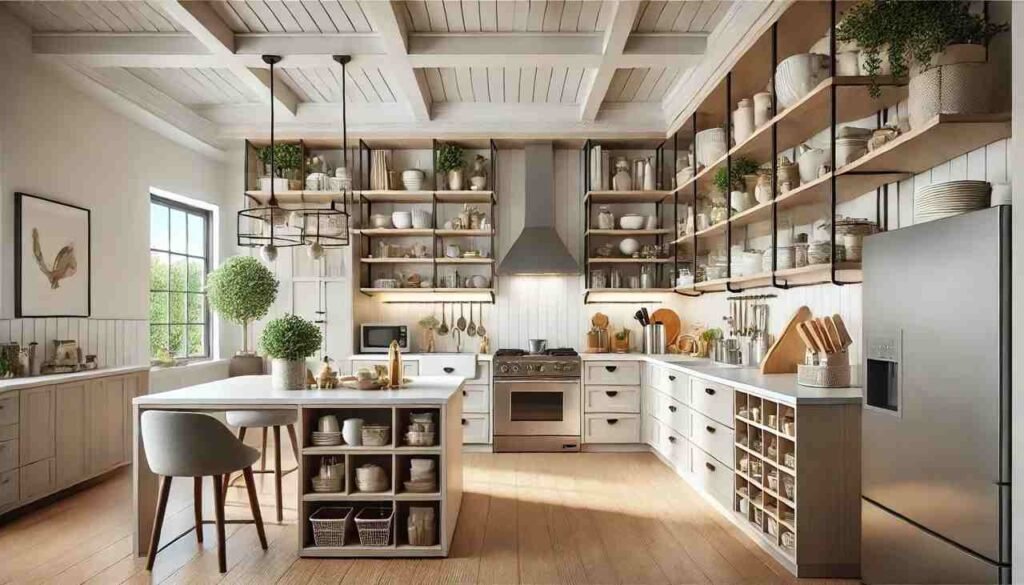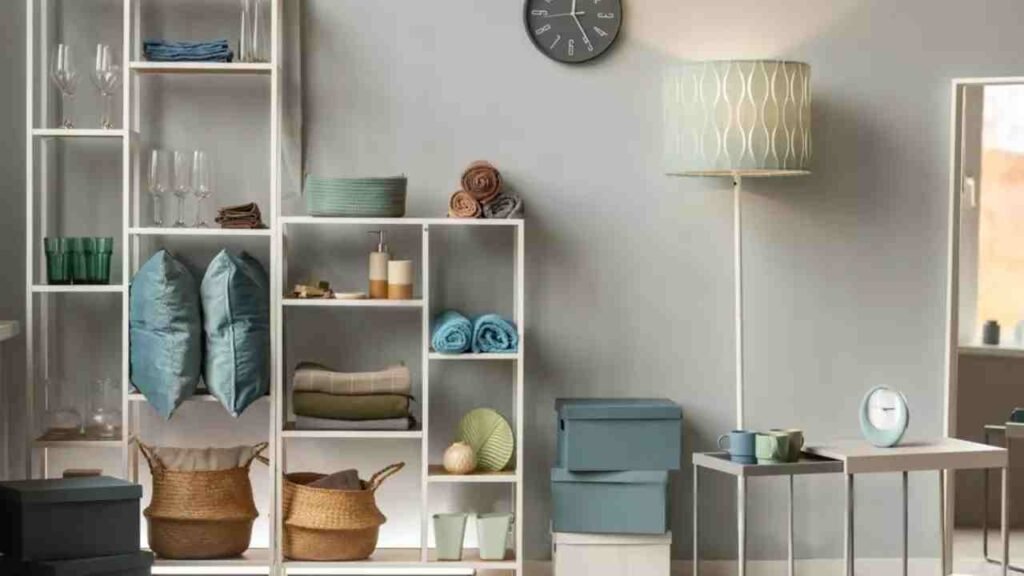When it comes to kitchen design, one of the biggest decisions homeowners face is whether to choose open shelving or traditional cabinets. Both options have their unique appeal, but they come with their own sets of advantages and challenges. Do you prefer an airy, open feel or a more organized, tucked-away approach? In this post, we’ll dive into the pros and cons of each with the support of The Noble Home Pros, helping you make an informed decision about which style best suits your needs and enhances your kitchen’s functionality.


Cabinetry and shelving services offer open shelving for a modern, minimalist aesthetic and make items easily accessible, while traditional cabinets provide more concealed storage and a classic look. The right choice often depends on your lifestyle, space, and personal preferences. If you enjoy displaying decorative items and have a tidy, organized kitchen, open shelving could be the way to go. On the other hand, if you prefer a clean, uncluttered look with ample storage, traditional cabinets may be the better option for your home. With the right cabinetry and shelving services, you can find the perfect balance between style and functionality for your kitchen.
The Appeal of Open Shelving: A Modern Touch for Your Kitchen
Open shelving offers a sleek, modern aesthetic that many homeowners love for its minimalist appeal. It creates a light and airy feel, making smaller kitchens appear larger. This design choice allows you to showcase dishes, glassware, and decorative items, adding personality and character to the space. Open shelving can turn everyday kitchen items into beautiful displays, transforming your kitchen into a more dynamic and visually appealing space. It’s also an excellent option for those who love to show off their culinary style or have a collection of vintage kitchenware. However, it’s important to stay organized and keep the shelves tidy, as open shelving exposes everything, which can quickly lead to clutter if not maintained. When considering custom closet shelving, ensure the design complements the space’s overall layout and meets your storage needs.
The Classic Charm of Traditional Cabinets
Traditional cabinets are a timeless choice, providing a clean, polished look that complements various kitchen styles. They offer concealed storage, keeping everything neatly tucked away and out of sight. This style is perfect for homeowners who prefer a more organized and clutter-free kitchen. Traditional cabinets come in a wide range of materials, finishes, and designs, allowing for endless customization options to match your overall kitchen theme. They provide a sense of structure and can make a kitchen feel more formal and sophisticated. For those who prioritize a traditional, classic style over the modern, open feel of shelving, cabinets offer both functional and aesthetic benefits that have stood the test of time. When considering installation, deciding between DIY vs. professional cabinet installation depends on your skill level, time constraints, and desired results.
Accessibility vs. Concealed Storage: Which Is Right for You?
One of the key differences between open shelving and traditional cabinets is accessibility. Open shelving makes items easy to reach, which is ideal for those who use their kitchenware frequently. It can be a practical solution for storing items like spices, plates, or utensils, allowing for quick access while cooking. On the other hand, traditional cabinets provide concealed storage, keeping everything out of view. This option is better for storing items you don’t need to access as often or for those who prefer a tidier, more organized space. Depending on your needs, you may want to choose one over the other, or perhaps a combination of both for the best of both worlds.
Maintenance: How Open Shelving Compares to Traditional Cabinets
When it comes to maintenance, open shelving requires more attention than traditional cabinets. Since everything is exposed, you’ll need to keep the shelves tidy and regularly dusted to maintain a clean look. Open shelving can accumulate grease and grime from cooking, so cleaning should be more frequent. Traditional cabinets, on the other hand, offer a more low-maintenance solution since they hide items from view. With cabinets, you’re less likely to deal with dust buildup, and the interior can be cleaned without much effort. While cabinets require occasional wiping and upkeep, they are generally easier to manage in terms of cleanliness, especially if your kitchen sees heavy use.
Space Efficiency: Maximizing Storage in Your Kitchen
Space efficiency is one of the biggest factors when deciding between open shelving and traditional cabinets. Open shelving can be a great choice for smaller kitchens as it allows for a more open and airy feel, making the space appear larger. However, it offers limited storage options, especially if you have a lot of kitchen items to store. Traditional cabinets provide more space for storage, especially with the ability to add features like pull-out drawers, lazy Susans, and built-in dividers. Cabinets are better suited for organizing items that you don’t use regularly, such as bulky appliances or extra pantry supplies, ensuring that everything stays neatly stored and easily accessible when needed.
The Aesthetic Factor: How Open Shelving Enhances or Hinders Your Decor
The aesthetic factor plays a significant role in the appeal of both open shelving and traditional cabinets. Open shelving can enhance your kitchen’s decor by showcasing your favorite kitchenware or decorative pieces. It’s perfect for those who love a contemporary or rustic look, and it can even serve as an artistic display. However, if not properly organized, open shelves can make a space look cluttered or chaotic. Traditional cabinets, in contrast, create a more polished and cohesive appearance. They can contribute to a more classic, elegant look and allow for seamless integration with the rest of your kitchen’s design. Ultimately, it comes down to your personal style and how much visual clutter you’re willing to embrace.
Organization and Clutter: Can Open Shelving Stay Tidy?
One of the challenges with open shelving is maintaining organization and avoiding clutter. Since everything is visible, it requires regular tidying up to ensure the shelves don’t look disorganized. The items on the shelves must be carefully arranged and kept to a minimum to avoid a cluttered appearance. Open shelving works best for people who enjoy organizing and keeping their kitchenware neat and tidy. However, if you have a busy household or tend to accumulate items quickly, keeping open shelves in order can be a constant struggle. On the other hand, traditional cabinets offer hidden storage, so organization is less of an issue. You can keep all your items neatly stashed away without worrying about keeping the space visually appealing at all times.


The Cost: Comparing Expenses Between Open Shelving and Traditional Cabinets
The cost of open shelving versus traditional cabinets varies depending on materials, design, and installation. Open shelving can be more affordable upfront, especially if you’re installing floating shelves made from simple materials like wood or metal. This design typically requires less material and labor, making it a budget-friendly option. Traditional cabinets, however, tend to be more expensive due to the materials used, the craftsmanship required, and the installation process. Custom cabinetry can add even more to the cost. While open shelving may seem more economical initially, traditional cabinets provide greater long-term value by offering better storage capacity, durability, and functionality, which might justify the higher initial investment for many homeowners.
Longevity and Durability: Which Option Lasts Longer?
When considering longevity and durability, traditional cabinets generally come out on top. Cabinets are built to withstand the test of time, especially if made from quality materials like solid wood. They are designed to hold up to everyday wear and tear, including weight-bearing capabilities for storing heavy items. Open shelving, while functional, may not offer the same level of durability. Shelves can get scratched or dented over time, especially if made from less sturdy materials. Open shelving also faces the challenge of dust and grease buildup, which can affect its appearance and longevity. However, if you choose high-quality materials for your shelves and maintain them properly, they can still last for many years.
Customization Options: Tailoring Open Shelving and Cabinets to Your Needs
Customization is another important factor to consider when deciding between open shelving and traditional cabinets. Both options offer a wide range of customization possibilities, but traditional cabinets tend to provide more flexibility in terms of organization. You can design cabinets to include pull-out drawers, dividers, and shelves tailored to your specific needs. Open shelving, while not as customizable, can still be adjusted to some extent by varying the number and size of shelves. If you’re looking for a more personalized and functional design, traditional cabinets may be a better option, but open shelving offers a more visually dynamic and minimalist solution. Ultimately, the level of customization you desire will impact your choice.
Resale Value: How Open Shelving vs. Traditional Cabinets Affects Your Home’s Appeal
When it comes to resale value, traditional cabinets tend to have broader appeal. Most homebuyers prefer the classic, clean look of cabinetry, especially in kitchens where storage is a priority. Well-designed cabinets can increase the resale value of your home by offering functional, aesthetically pleasing storage solutions. Open shelving, while trendy and modern, may not have the same universal appeal, as some buyers might view it as impractical or too difficult to maintain.
Conclusion
In conclusion, choosing between open shelving and traditional cabinets depends on your personal style, storage needs, and maintenance preferences. Open shelving offers a modern, minimalist aesthetic and easy access to items, making it ideal for those who love displaying their kitchenware. However, it requires regular maintenance to avoid clutter and dust accumulation. Traditional cabinets, on the other hand, provide more concealed storage, a timeless look, and are generally easier to maintain, making them a great option for those who prioritize organization and cleanliness. Ultimately, the decision comes down to your lifestyle, how much space you have, and how much upkeep you’re willing to commit to. Consider blending both styles for a balanced, functional kitchen design.
FAQs
What are the advantages of open shelving?
Open shelving provides easy access to kitchen items and creates a more open, airy feel in the space. It’s also great for showcasing attractive dishware or decor.
What are the downsides of open shelving?
Open shelving requires more frequent cleaning and organization to prevent clutter and dust buildup. It also leaves items exposed, which can lead to a less tidy appearance.
Are traditional cabinets more practical than open shelving?
Traditional cabinets offer concealed storage, which keeps kitchen items out of sight and reduces the need for constant cleaning. They provide more space for hiding less visually appealing items.
Can I combine open shelving and traditional cabinets?
Yes, combining both styles is a popular trend, offering the best of both worlds: open shelving for frequently used items and cabinets for storage that you want to keep out of view.
Which option is better for small kitchens?
Traditional cabinets are often a better choice for small kitchens, as they offer more efficient storage without overwhelming the space. However, strategically placed open shelves can help maximize storage in smaller areas.
